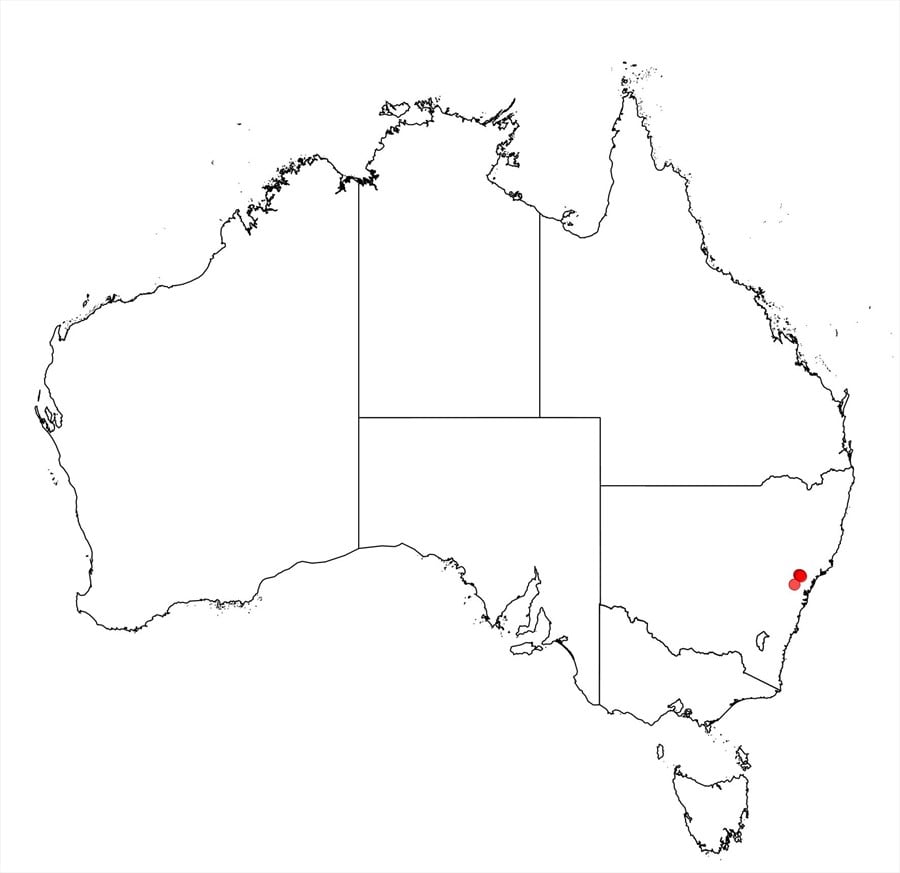Acacia alaticaulis Kodela & Tindale
WATTLE
Acacias of Australia
Family
Fabaceae
Distribution
Localised in the Howes Mtn area and at Mt Murwin, Yengo Natl Park, N.S.W.
Description
Spindly or straggly shrub to small tree to 4 m high; branches often pendulous. Branchlets glabrous or very sparsely puberulous, with convoluted, winged ridges to 3 mm high. Leaves dark to mid-green above, paler below; petiole to 5 mm long but often less than 1 mm, winged, glabrous or almost so, with a gland 1–2 mm long; rachis (1.4–) 2.5–8.5 cm long, sometimes absent, winged, ±glabrous or sparsely puberulous, often with a small gland at base of terminal and rarely other pair(s) of pinnae, interjugary glands absent; pinnae (1–) 3–10 pairs, (1.2) 2.5–4.5 (–6) cm long; pinnules 7–17 pairs, well-spaced, oblong to narrowly oblong, narrowly ovate to lanceolate or narrowly obovate, 2.6–9 (–11) mm long, 0.9–3 (–3.6) mm wide, recurved, mostly glabrous, apex acuminate or acute. Inflorescences in axillary or terminal racemes or panicles; raceme axes to 33.5 cm long, winged. Peduncles 5–17 mm long, ±hairy. Heads (6–) 8–16-flowered, cream-coloured to pale yellow. Pods straight-sided or sometimes irregularly constricted between seeds, normally curved, 6–12 cm long, 11–13 mm wide, coriaceous, reddish brown or blackish brown, with minor transverse veins, sometimes rough over seeds, glabrous; margins prominent, paler.
Phenology
Flowers Dec.–May; fruits Nov.
Habitat
Grows in sandy and sandy clay soils, on ridges and hillslopes, on sandstone or at the junction of shale and sandstone, in eucalypt woodland or open forest with shrub understorey.
Specimens
N.S.W.: Howes Mtn, 80 miles [128 km] N of Windsor on the Windsor Singleton rd, R.G.Coveny 4108 & R.Bisby (BRI, CANB, K, MEL, NSW, US), R.G.Coveny 10209 & J.Seur (A, AD, BRI, CANB, HO, L, NSW, PERTH, US, Z) and P.G.Kodela 270 & T.A.James (CANB, MEL, NSW).
Notes
This species was treated as Acacia sp. A by P.G.Kodela & M.D.Tindale, Fl. Australia 11A: 221 (2001). It is allied to A. terminalis and A. sp. Kulnura (R.G.Coveny 4142); distinguished from the latter by the winged branchlets, petioles and rachises, almost glabrous branchlets and foliage, as well as often having shorter bracts and slightly narrower pods.
FOA Reference
Data derived from Flora of Australia Volumes 11A (2001), 11B (2001) and 12 (1998), products of ABRS, ©Commonwealth of Australia
Author
Revised by B.R.Maslin & P.G.Kodela
P.G.Kodela
This identification key and fact sheets are available as a mobile application:
URL: https://apps.lucidcentral.org/wattle/
© Copyright 2018. All rights reserved.






